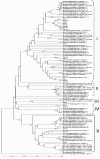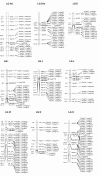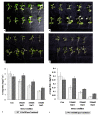Identification and analysis of the germin-like gene family in soybean
- PMID: 21059215
- PMCID: PMC3011853
- DOI: 10.1186/1471-2164-11-620
Identification and analysis of the germin-like gene family in soybean
Erratum in
- BMC Genomics. 2011;12:16
Abstract
Background: Germin and germin-like proteins constitute a ubiquitous family of plant proteins. A role of some family members in defense against pathogen attack had been proposed based on gene regulation studies and transgenic approaches. Soybean (G. max L. Merr.) germin genes had not been characterized at the molecular and functional levels.
Results: In the present study, twenty-one germin gene members in soybean cultivar 'Maple Arrow' (partial resistance to Sclerotinia stem rot of soybean) were identified by in silico identification and RACE method (GmGER 1 to GmGER 21). A genome-wide analyses of these germin-like protein genes using a bioinformatics approach showed that the genes located on chromosomes 8, 1, 15, 20, 16, 19, 7, 3 and 10, on which more disease-resistant genes were located on. Sequence comparison revealed that the genes encoded three germin-like domains. The phylogenetic relationships and functional diversity of the germin gene family of soybean were analyzed among diverse genera. The expression of the GmGER genes treated with exogenous IAA suggested that GmGER genes might be regulated by auxin. Transgenic tobacco that expressed the GmGER 15 [corrected] gene exhibited high tolerance to the salt stress. In addition, the GmGER mRNA increased transiently at darkness and peaked at a time that corresponded approximately to the critical night length. The mRNA did not accumulate significantly under the constant light condition, and did not change greatly under the SD and LD treatments.
Conclusions: This study provides a complex overview of the GmGER genes in soybean. Phylogenetic analysis suggested that the germin and germin-like genes of the plant species that had been founded might be evolved by independent gene duplication events. The experiment indicated that germin genes exhibited diverse expression patterns during soybean development. The different time courses of the mRNAs accumulation of GmGER genes in soybean leaves appeared to have a regular photoperiodic reaction in darkness. Also the GmGER genes were proved to response to abiotic stress (such as auxin and salt), suggesting that these paralogous genes were likely involved in complex biological processes in soybean.
Figures







References
-
- Lane BG. Cellular desiccation and hydration: developmentally regulated proteins, and the maturation and germination of seed embryos. FASEB Journal. 1991;5:2893–2901. - PubMed
-
- Dumas B, Sailland A, Cheviet JP, Freyssinet G, Pallett K. Identification of barley oxalate oxidase as a germin-like protein. Comptes Rendus de l'Academie des Sciences Serie 3 Sciences de la Vie (France) 1993;316:793–782. - PubMed
-
- Heintzen C, Fischer R, Melzer S, Kappeler S, Apel K, Staiger D. Circadian oscillations of a transcript encoding a germin like protein that is associated with cell walls in young leaves of the long-day plant. Sinapis alba L. Plant Physiology. 1994;106:905–915. doi: 10.1104/pp.106.3.905. - DOI - PMC - PubMed
Publication types
MeSH terms
Substances
Associated data
- Actions
- Actions
- Actions
- Actions
- Actions
- Actions
- Actions
- Actions
- Actions
- Actions
- Actions
- Actions
- Actions
- Actions
- Actions
- Actions
- Actions
- Actions
- Actions
- Actions
- Actions
LinkOut - more resources
Full Text Sources
Other Literature Sources
Research Materials

